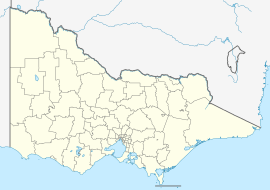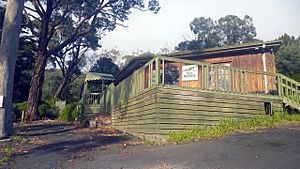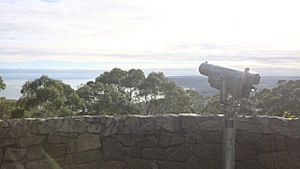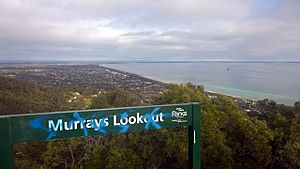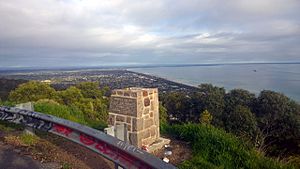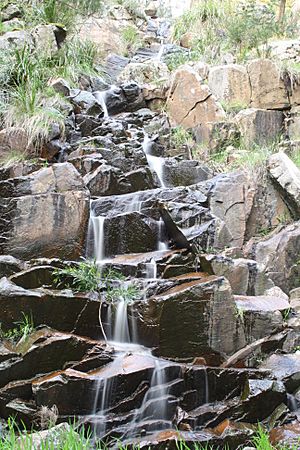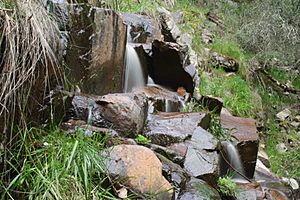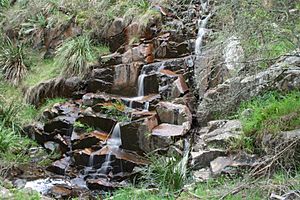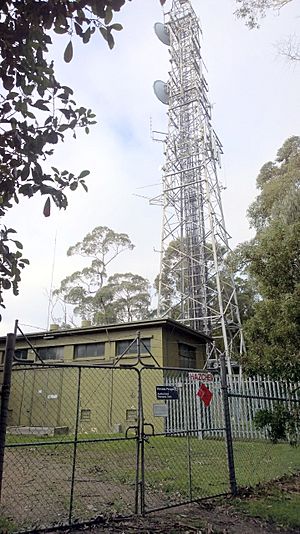Arthurs Seat, Victoria facts for kids
Quick facts for kids Arthurs SeatVictoria |
|||||||||||||||
|---|---|---|---|---|---|---|---|---|---|---|---|---|---|---|---|
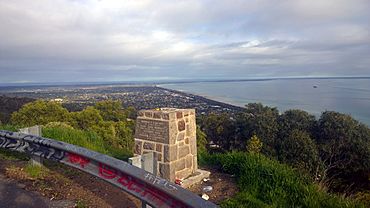
View from Arthurs Seat towards Port Phillip heads
|
|||||||||||||||
| Population | 394 (2016 census) | ||||||||||||||
| • Density | 263/km2 (680/sq mi) | ||||||||||||||
| Postcode(s) | 3936 | ||||||||||||||
| Area | 1.5 km2 (0.6 sq mi) | ||||||||||||||
| Time zone | AEST (UTC+10) | ||||||||||||||
| • Summer (DST) | AEDT (UTC+11) | ||||||||||||||
| Location | 85 km (53 mi) from Melbourne | ||||||||||||||
| LGA(s) | Shire of Mornington Peninsula | ||||||||||||||
| State electorate(s) | Nepean | ||||||||||||||
| Federal Division(s) | Flinders | ||||||||||||||
|
|||||||||||||||
Arthurs Seat is a beautiful hill and small town on the Mornington Peninsula in Australia. It's about 85 kilometers (53 miles) southeast of Melbourne. The local Aboriginal people, the Boonwurrung, called this hill Wonga.
Arthurs Seat is a popular place for tourists. People love its natural bushland, amazing views, and fun attractions. The hill stands tall at 314 meters (1,030 feet) above the sea.
The rocks that make up Arthurs Seat are very old, formed from granite. The area has dry forests with different types of eucalypt trees. These forests have faced big bushfires in the past, like in 1973 and 1997.
A Look Back: History of Arthurs Seat
The Boonwurrung People
Long before Europeans arrived, the Boonwurrung people lived around Wonga. The lower parts of the hill were known as Wango. This was a special place where important gatherings called corroborees were held. The Boonwurrung had a few names for the hill, including Momo and Tubberrubberbil.
How Arthurs Seat Got Its Name
The name Arthurs Seat was first given to the mountain range. Over time, it referred to different areas, eventually becoming the name for the town at the top of the hill.
In February 1802, Acting Lieutenant John Murray sailed into Port Phillip. He named the hill Arthurs Seat because it reminded him of a hill back home in Edinburgh, Scotland, which is also called Arthur's Seat.
Early Explorers and Lookouts
Captain Matthew Flinders climbed Arthurs Seat on April 27, 1802. He wrote in his log that it was a great spot for looking out over the land. Another famous climb happened in 1844 when Sir John Franklin, a former governor, explored the hill.
In 1853, a special survey station was built on the summit. This was used to help map the area. Later, in 1883, a wooden lighthouse that was no longer needed was moved to the summit. It became a lookout tower until 1934.
Roads and Early Tourism
In 1913, a track was made for vehicles to reach the summit. This track was improved and widened in 1929.
The summit area of Arthurs Seat became its own recognized town in 1930. Before that, it was often called "Dromana Park" or "Arthurs Seat Range."
A fun place called the Garden of the Moon opened in 1931. It had a dance hall, telescopes, a swimming pool, and a wishing well, bringing many visitors. The lookout tower opened in 1934. In 1960, a 950-meter-long chairlift was built, making the area even more popular.
Arthurs Seat Today
What to See and Do
Today, Arthurs Seat is home to the Arthurs Seat State Park, which includes the beautiful "Seawinds" gardens. You can also find a maze, restaurants, and a car museum. From the viewing areas near the top, you can see amazing views of Port Phillip Bay. On a clear day, you might even spot the Melbourne city skyline and the You Yangs mountains far away.
Scenic Drives and Lookouts
A winding road connects the summit to the nearby town of Dromana. This road, opened in 1929, offers access to several viewpoints. These include Bowens Point, Franklin Point, Murrays Lookout, and Chapmans Point. Murrays Lookout is often considered the best spot for views of the peninsula.
Walking Tracks
Arthurs Seat has many walking tracks for you to explore. It's a great way to experience the bushland.
Two Bays Walking Track
The Two Bays walking track goes through Arthurs Seat State Park. This long track stretches all the way from Dromana to Cape Schanck. It's the longest continuous walking track on the Mornington Peninsula. Parks Victoria suggests doing smaller parts of the track, like the Arthurs Seat section, rather than trying to walk the whole thing at once.
Kings Falls Track & Circuit Walk
The Kings Falls Track & Circuit Walk is a lovely walk for most people. It starts at the car park on Waterfall Gully Road. The path is mostly dirt, but some parts have boardwalks and steps, making it easier on steeper sections. About 250 meters along the path, there's a lookout where you can see the waterfall.
TC McKeller Circuit Walk
Cook Street Track
Sea Winds Gardens
Sea Winds Gardens is a special part of the park near the summit. It's cared for by Parks Victoria and volunteers. You can get to Sea Winds from Purves Road, close to the summit.
These gardens cover 34 hectares (about 84 acres) at the very top of Arthurs Seat, 305 meters (1,000 feet) above sea level. From the Bay and Northern Lookouts, you get amazing views of Port Phillip Bay and the Mornington and Bellarine Peninsulas.
The gardens mix native plants with beautiful plants from other countries. There are walking tracks, picnic tables, electric BBQs, and toilets. It's a great spot for a family picnic.
Arthurs Seat Chairlift
Its Story and Changes
A chairlift was first built at Arthurs Seat by an engineer named Vladimir Hájek and opened on December 21, 1960. It was a popular tourist attraction, offering fantastic views over Port Phillip Bay. The chairlift rose 225 meters (738 feet) over almost a kilometer. It ran for over 40 years.
After being closed for several years, the old chairlift was removed. It has now been replaced by a modern ride called the Arthurs Seat Eagle.
Safety and New Beginnings
There were some safety issues with the old chairlift, which led to its closure in 2006. For example, in 2003, a support tower collapsed, and in 2004, a chair came loose. These events led to stricter safety rules for chairlifts in Victoria.
In 2009, Parks Victoria started looking for a company to build a new, modern chairlift. The old chairlift's towers were removed, and the top station was taken down by early 2013. The old Arthurs Seat lookout tower was also removed because it was no longer safe.
In June 2014, the Mornington Shire Council approved plans for the new chairlift. Many groups supported the project, including The National Trust and Tourism Victoria. Construction for the new chairlift began in October 2015, and it started carrying passengers in December 2016.


